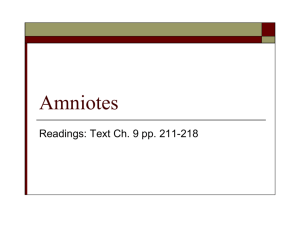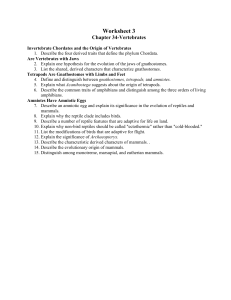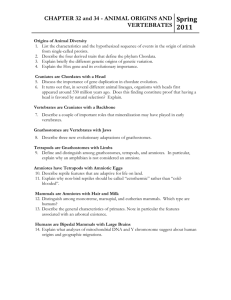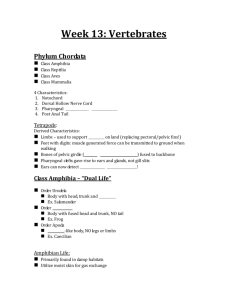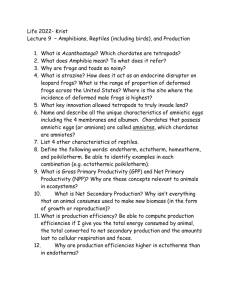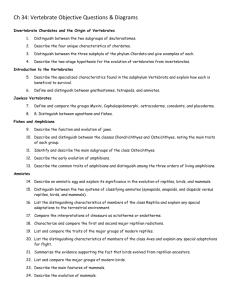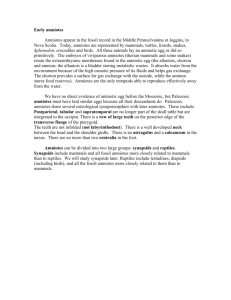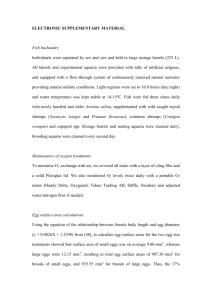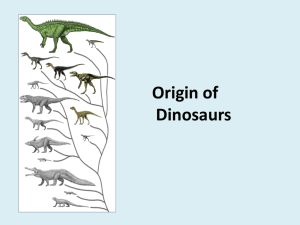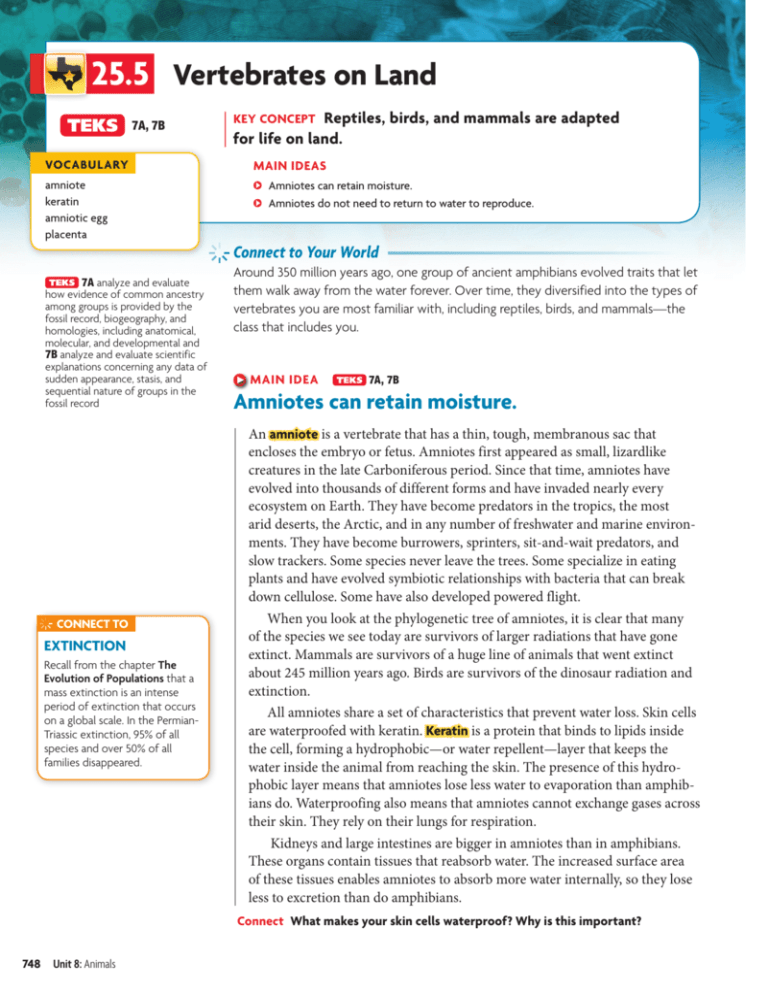
25.5 Vertebrates on Land
7A, 7B
VOCABULARY
amniote
keratin
amniotic egg
placenta
Key Concept Reptiles, birds, and mammals are adapted
for life on land.
MAIN IDEAS
Amniotes can retain moisture.
Amniotes do not need to return to water to reproduce.
Connect to Your World 7A analyze and evaluate
how evidence of common ancestry
among groups is provided by the
fossil record, biogeography, and
homologies, including anatomical,
molecular, and developmental and
7B analyze and evaluate scientific
explanations concerning any data of
sudden appearance, stasis, and
sequential nature of groups in the
fossil record
CONNECT TO
Extinction
Recall from the chapter The
Evolution of Populations that a
mass extinction is an intense
period of extinction that occurs
on a global scale. In the PermianTriassic extinction, 95% of all
species and over 50% of all
families disappeared.
Around 350 million years ago, one group of ancient amphibians evolved traits that let
them walk away from the water forever. Over time, they diversified into the types of
vertebrates you are most familiar with, including reptiles, birds, and mammals—the
class that includes you.
MAIN IDEA 7A, 7B
Amniotes can retain moisture.
An amniote is a vertebrate that has a thin, tough, membranous sac that
encloses the embryo or fetus. Amniotes first appeared as small, lizardlike
creatures in the late Carboniferous period. Since that time, amniotes have
evolved into thousands of different forms and have invaded nearly every
ecosystem on Earth. They have become predators in the tropics, the most
arid deserts, the Arctic, and in any number of freshwater and marine environments. They have become burrowers, sprinters, sit-and-wait predators, and
slow trackers. Some species never leave the trees. Some specialize in eating
plants and have evolved symbiotic relationships with bacteria that can break
down cellulose. Some have also developed powered flight.
When you look at the phylogenetic tree of amniotes, it is clear that many
of the species we see today are survivors of larger radiations that have gone
extinct. Mammals are survivors of a huge line of animals that went extinct
about 245 million years ago. Birds are survivors of the dinosaur radiation and
extinction.
All amniotes share a set of characteristics that prevent water loss. Skin cells
are waterproofed with keratin. Keratin is a protein that binds to lipids inside
the cell, forming a hydrophobic—or water repellent—layer that keeps the
water inside the animal from reaching the skin. The presence of this hydrophobic layer means that amniotes lose less water to evaporation than amphibians do. Waterproofing also means that amniotes cannot exchange gases across
their skin. They rely on their lungs for respiration.
Kidneys and large intestines are bigger in amniotes than in amphibians.
These organs contain tissues that reabsorb water. The increased surface area
of these tissues enables amniotes to absorb more water internally, so they lose
less to excretion than do amphibians.
Connect What makes your skin cells waterproof? Why is this important?
748 Unit 8: Animals
MAIN IDEA
©Zigmund Leszczynski/Animals Animals/Earth Scenes. All rights reserved.
Amniotes do not need to return
to water to reproduce.
With adaptations that limit water loss, amniote adults
could move into drier environments on land. But it was
the evolution of the amniotic egg that let them stay
there. The amniotic egg is an almost completely
waterproof container that keeps the embryo from
drying out as it develops. After it evolved, amniotes did
not have to return to a wet environment to reproduce.
An amniotic egg, shown in Figure 5.1, is essentially
a private pool that the mother builds for her embryo.
Like any swimming pool, the egg is expensive. In egglaying amniotes, the mother must make enough yolk
and white to feed the embryo until it hatches, then
build the shell around the fertilized egg. Each egg
represents a large investment of energy. For example, a
bird may lose 5 to 30% of its body weight as it makes an egg.
Other amniotes, such as rattlesnakes and garter snakes, make eggs but
do not lay them. Instead, they keep their eggs in their oviduct until they
hatch. Retaining eggs protects them from predators. Some amniotes have
evolved the ability to give birth to living, well-developed young.
Most mammal embryos develop inside of the mother’s reproductive tract.
Their eggs have no shells, but their embryos make the same series of membranes
found in a typical amniotic egg. The placenta is a membranous organ that
develops in female mammals during pregnancy. It lines the uterine wall and
partially envelops the fetus. The placenta carries nutrients from the mother
to the embryo and also removes metabolic wastes from the embryo.
FIGURE 5.1 Amniotes, such
as this gecko, develop within
an amniotic egg.
Summarize How is an amniotic egg protected from water loss?
Self-check Online
25.5
Formative Assessment
Reviewing Main Ideas
1. What anatomical characteristics help
an amniote retain moisture?
7a
2. Why don’t amniotes need to return
to water to reproduce?
Critical thinking
3. Infer If eggshells were thicker, the
egg would lose even less water to the
environment. Why are eggshells thin?
4. Infer What is an advantage of giving
birth to live young, rather than having
young that hatch from eggs?
HMDScience.com
go online
CONNECT TO
Evolution
5. Most mammals, and at least
some lizards and snakes, have
evolved live birth by keeping
the eggs inside the mother
until they hatch. However, no
bird species has ever retained
its eggs. Suggest a possible
explanation for this fact.
Chapter 25: Vertebrate Diversity 749

